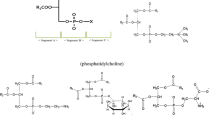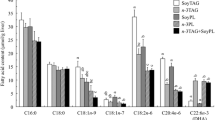Abstract
We compared the effects of three different high-lipid diets on plasma lipoproteins and phospholipids in mink (Mustela vison). The 18 mink studied were fed one of the three diets during a 25-d period in a parallel group design. The compared diets had 0,17, and 67% extracted lipids from natural gas-utilizing bacteria (LNGB), which were rich in PE. The group with 0% LNGB was fed a diet for which the lipid content was 100% soybean oil. The total cholesterol, LDL cholesterol, and HDL cholesterol of animals consuming a diet with 67% LNGB (67LNGB-diet), were significantly lowered by 35, 49, and 29%, respectively, and unesterified cholesterol increased by 17% compared with the animals fed a diet of 100% lipids from soybean oil (SB-diet). In addition, the ratio of LDL cholesterol to HDL cholesterol was 27% lower in mink fed the 67LNGB-diet than those fed the SB-diet. When the mink were fed the 67LNGB-diet, plasma PC, total phospholipids, lysoPC, and PI were lowered significantly compared with the mink fed a SB-diet. Plasma total cholesterol was correlated with total phospholipids as well as with PC (R=0.8, P<0.001). A significantly higher fecal excretion of unesterified cholesterol, cholesteryl ester, PC, lysoPC, and PE was observed in the 67LNGB-fed mink compared with the SB-fed mink. We conclude that phospholipids from the 67LNGB-diet decreased plasma lipoprotein levels, the LDL/HDL cholesterol ratio, and plasma phospholipid levels, especially lysoPC and PC, compared with the highly unsaturated soybean oil. Our findings indicate that the decrease of plasma cholesterol is mainly caused by a specific mixture of phospholipids containing a high level of PE, and not by the dietary FA composition. The lack of significant differences in the level of plasma PE due to the diets indicates that most of the PE from LNGB has been converted to PC in the liver. Thus, plasma cholesterol may at least be partly regulated by phospholipid methylation from PE to PC in the liver.
Similar content being viewed by others
Abbreviations
- 17LNGB-diet:
-
diet with 17% lipids from natural gas-utilizing bacteria (LNGB)
- 67LNGB-diet:
-
diet with 67% LNGB and 33% soybean oil
- CDP:
-
cytidine diphosphate
- CETP:
-
cholesteryl ester transfer protein
- CL:
-
cardiolipin
- HPTLC:
-
high-performance TLC
- PEMT:
-
PE methyltransferase
- PG:
-
phosphatidylglycerol
- PI:
-
phosphatidylinositol
- SB-diet:
-
diet with 100% lipids from soybean oil
- SM:
-
sphingomyelin
References
Åkesson, B. (1982) Content of Phospholipids in Human Diets Studied by the Duplicate-Portion Technique, Br. J. Nutr. 47, 223–229.
Lucas, C.C., and Ridout, J.H. (1967) Fats and Other Lipids, Progr. Chem. 10, 1.
Skrede, A., Berge, G.M., Storebakken, T., Herstad, O., Aarstad, K.G., and Sundstøl, F. (1998) Digestibility of Bacterial Protein Grown on Natural Gas in Mink, Pigs, Chicken and Atlantic Salmon, Anim. Feed. Sci. Technol. 76, 103–116.
Hanson, R.S., and Hanson, T.E. (1996) Methanotrophic Bacteria, Microbiol. Rev. 60, 439–471.
Makula, R.A. (1978) Phospholipid Composition of Methane-Utilizing Bacteria, J. Bacteriol. 134, 771–777.
Murata, M., Imaizumi, K., and Sugano, M. (1982) Effect of Dietary Phospholipids and Their Constituent Bases on Serum Lipids and Apolipoproteins in Rats, J. Nutr. 112, 1805–1808.
Imaizumi, K., Mawatari, K., Murata, M., Ikeda, I., and Sugano, M. (1983) The Contrasting Effect of Dietary Phosphotidylethanolamine and Phosphatidylcholine on Serum Lipoproteins and Liver Lipids in Rats, J. Nutr. 113, 2403–2411.
Sugiyama, K., Ohishi, A., Siyu, H., and Takeuchi, H. (1989) Efects of Methyl-Group Acceptors on the Regulation of Plasma Cholesterol Level in Rats Fed High Cholesterol Diets, J. Nutr. Sci. Vitaminol. 35, 613–626.
Morrison L.M. (1958) Serum Cholesterol Reduction with Lecithin, Geriatrics 13, 12–19.
Childs, M.T., Bowlin, J.A., Ogilvie, J.T., Hazzard, W.R., and Albers, J.J. (1981) The Contrasting Effects of a Dietary Soya Lecithin Product and Corn Oil on Lipoprotein Lipids in Normolipidemic and Familial Hypercholesterolemic Subjects, Atherosclerosis 38, 217–228.
Knuiman, J.T., Beynen, A.C., and Katan, M.B. (1989) Lecithin Intake and Serum Cholesterol, Am. J. Clin. Nutr. 49, 266–268.
Bondesson G., Hedbom, C., Magnusson, O., and Stjernstrom, N.E. (1974) Potential Hypolipidemic Agents. X. Plasma Lipid-Lowering Properties of Some Aliphatic Aminoalcohols, Acta Pharm. Suec. 11, 417–426.
O'Brien, B.C., and Andrews, V.G. (1993) Influence of Dietary Egg and Soybean Phospholipids and Triacylglycerols on Human Serum Lipoproteins, Lipids 28, 7–12.
Childs, M.T., Bowlin, J.A., Ogilvie, J.T., Hazzard, W.R., and Albers, J.J. (1981) The Contrasting Effects of a Dietary Soya Lecithin Product and Corn Oil on Lipoprotein Lipids in Normolipidemic and Familial Hypercholesterolemic Subjects, Atherosclerosis 38, 217–228.
Noga, A.A., and Vance, D.E. (2003) A Gender-Specific Role for Phosphatidylethanolamine N-Methyltransferase-Derived Phosphatidylcholine in the Regulation of Plasma High Density and Very Low Density Lipoproteins in Mice, J. Biol. Chem. 278, 21851–21859.
Tijburg, L.B.M., Geelen, M.J.H., and van Golde, L.M.G. (1989) Regulation of the Biosynthesis of Triacylglycerol, Phosphatidylcholine and Phosphatidylethanolamine in the Liver, Biochem. Biophys. Acta 1004, 1–19.
DeLong, C.J., Hicks, A.M., and Cui, Z. (2002) Disruption of Choline Methyl Group Donation for Phosphatidylethanolamine Methylation in Hepatocarcinoma cells, J. Biol. Chem. 277, 17217–17225.
Sehayek, E., Wang, R., Ono, J.G., Zinchuk, V.S., Duncan, E.M., Shefer, S., Vance, D.E., Ananthanaryanan, M., Chait, B.T., and Breslow, J.L. (2003) Localization of the PE Methylation Pathway and SR-BI to the Canalicular Membrane: Evidence for Apical PC Biosynthesis That May Promote Biliary Excretion of Phospholipid and Cholesterol, J. Lipid Res. 44, 1605–1613.
Skrede, A., and Cheeke, P.R. (2004) Feeding and Nutrition of Fur-Bearing Animals, in Applied Animal Nutrition, 3rd edn., pp. 514–522, Pearson Prentice Hall, Upper Saddle River, NJ.
Folch, J., Lees, M., and Sloane Stanley, G.H. (1957) A Simple Method for the Isolation and Purification of Total Lipids from Animal tissues, J. Biol. Chem. 226, 497–509.
Nes, N., Einarsson, E.J., and Lohi, O. (1988) Beautiful Fur Animals and Their Colour Genetics, (Jørgensen, G., ed.), pp. 155–160, Scientifur, Hillerød, Denmark.
National Research Council (1982) Nutrient Requirements of Mink and Foxes, 2nd rev. edn., National Academy Press, Washington, DC.
McCleary, B.V., Solah, V., and Gibson, T.S. (1994) Quantitative Measurements of Total Starch in Cereal Flours and Products, J. Cereal. Sci. 20, 51–58.
Bligh, E.G., and Dyer, W.J. (1959) A Rapid Method of Total Lipid Extraction and Purification, Can. J. Med. Sci. 37, 911–917.
Mason, M.E., and Waller, G.R. (1964) Dimethoxypropane Induced Transesterification of Fats and Oils in Preparation of Methyl Esters for Gas Chromatographic Analysis, Anal. Chem. 36, 583–586.
Macala, L.J., Yu, R.K., and Ando, S. (1983) Analysis of Brain Lipids by High Performance Thin-Layer Chromatography and Densitometry, J. Lipid Res. 24, 1243–1249.
Ruiz, J.I., and Ochoa, B. (1997) Quantification in the Subnanomolar Range of Phospholipids and Neutral Lipids by Monodimensional Thin-Layer Chromatography and Image Analysis, J. Lipid Res. 38, 1482–1489.
Siedel, J., Rollinger, W., Rôschlau, P., and Ziegenhorn, J. (1985) Total Cholesterol, End-point and Kinetic Method, in Methods of Enzymatic Analysis, 3rd edn. (Bergmeyer, H.U., ed.), Vol. 8, pp. 139–148, Weinheim, Germany.
Nägele, U., Wahlefeld, A.W., and Ziegenhorn, J. (1985) Triglycerides: Colorimetric Method, in Methods of Enzymatic Analysis, 3rd edn. (Bergmeyer, H.U., ed.), Vol. 8, pp. 12–18, Weinheim, Germany.
Friedewald, W.T., Lewy, R.I., and Fredrickson, D.S. (1972) Estimation of the Concentration of Low-Density Lipoprotein Cholesterol in Plasma, Without Use of the Preparative Ultracentrifuge, Clin. Chem. 18, 499–502.
Yu, S., Derr, J., Etherton, T.D., and Kris-Etherton, P.M. (1995) Plasma Cholesterol-Predictive Equations Demonstrate That Stearic Acid Is Neutral and Monounsaturated Fatty Acids Are Hypocholesterolemic, Am. J. Clin. Nutr. 61, 1129–1139.
Müller, H., Kirkhus, B., and Pedersen, J.I. (2001) Serum Cholesterol Predictive Equations with Special Emphasis on trans and Saturated Fatty Acids. An Analysis from Designed Controlled Studies, Lipids 36, 783–791.
Nestel, P., Clifton, P., and Noakes, M. (1994) Effects of Increasing Dietary Palmitoleic Acid Compared with Palmitic and Oleic Acids on Plasma Lipids of Hypercholesterolemic Men, J. Lipid Res. 35, 656–662.
Smith, D.R., Knabe, D.A., Cross, H.R., and Smith, S.B. (1996) A Diet Containing Myristoleic Plus Palmitoleic Acids Elevates Plasma Cholesterol in Young Growing Swine, Lipids 31, 849–858.
Goodnight, S.H., Harris, W.S., Connor, W.E., and Illingworth, D.R. (1982) Polyunsaturated Fatty Acids, Hyperlipidemia, and Thrombosis, Arteriosclerosis 2, 87–113.
Reo, N.V., Adinehzadeh, M., and Foy B.D. (2002) Kinetic Analyses of Liver Phosphatidylcholine and Phosphatidylethanolamine Biosynthesis Using 13C NMR Spectroscopy, Biochim. Biophys. Acta. 1580, 171–188.
Beynen, A.C., and Terpstra, A.H. (1983) Relationships Between Cholesterol and Phospholipid Concentrations in the Serum of Humans, Calves, Rabbits and Chickens, Comp. Biochem. Physiol. B 76, 737–740.
Kent, C. (1995) Eukaryotic Phospholipid Biosynthesis, Ann. Rev. Biochem. 64, 315–343.
Noga, A.A., and Vance, D.E. (2003) Insights into the Requirement of Phosphatidylcholine Synthesis for Liver Function in Mice, J. Lipid Res. 44, 1998–2005.
Dietschy, J.M., Turley, S.D., and Spady, D.K. (1993) Role of Liver in the Maintenance of Cholesterol and Low Density Lipoprotein Homeostasis in Different Animal Species, Including Humans, Review, J. Lipid Res. 34, 1637–1659.
Christophersen, B., Nordstoga, K., Shen, Y., Olivecrona, T., and Olivecrona, G. (1997) Lipoprotein Lipase Deficiency with Pancreatitis in Mink: Biochemical Characterization and Pathology, J. Lipid Res. 38, 837–846.
Homan, R., and Hamelehle, K.L. (1998) Phospholipase A2 Relieves Phosphatidylcholine Inhibition of Micellar Cholesterol Absorption and Transport by Human Intestinal Cell Line Caco-2, J. Lipid Res. 39, 1197–1209.
Tu, A.Y., Nishida, H.I., and Nishida, T. (1993) High Density Lipoprotein Conversion Mediated by Human Plasma Phospholipid Transfer Protein, J. Biol. Chem. 268, 23098–23105.
Nishimaki-Mogani, T., Yao, Z., and Fujimori, K. (2002) Inhibition of Phosphatidylcholine Synthesis via the Phosphatidylethanolamine Methylation Pathway Impairs Incorporation of Bulk Lipids into VLDL in Cultured Rat Hepatocytes, J. Lipid Res. 43, 1035–10445.
Noga, A.A., Zhao, Y., and Vance, D.E. (2002) An Unexpected Requirement for Phosphatidylethanolamine N-Methyltransferase in the Secretion of Very Low Density Lipoproteins, J. Biol. Chem. 277, 42358–42365.
Author information
Authors and Affiliations
Corresponding author
About this article
Cite this article
Müller, H., Hellgren, L.I., Olsen, E. et al. Lipids rich in phosphatidylethanolamine from natural gas-utilizing bacteria reduce plasma cholesterol and classes of phospholipids: A comparison with soybean oil. Lipids 39, 833–841 (2004). https://doi.org/10.1007/s11745-004-1304-5
Received:
Accepted:
Issue Date:
DOI: https://doi.org/10.1007/s11745-004-1304-5




